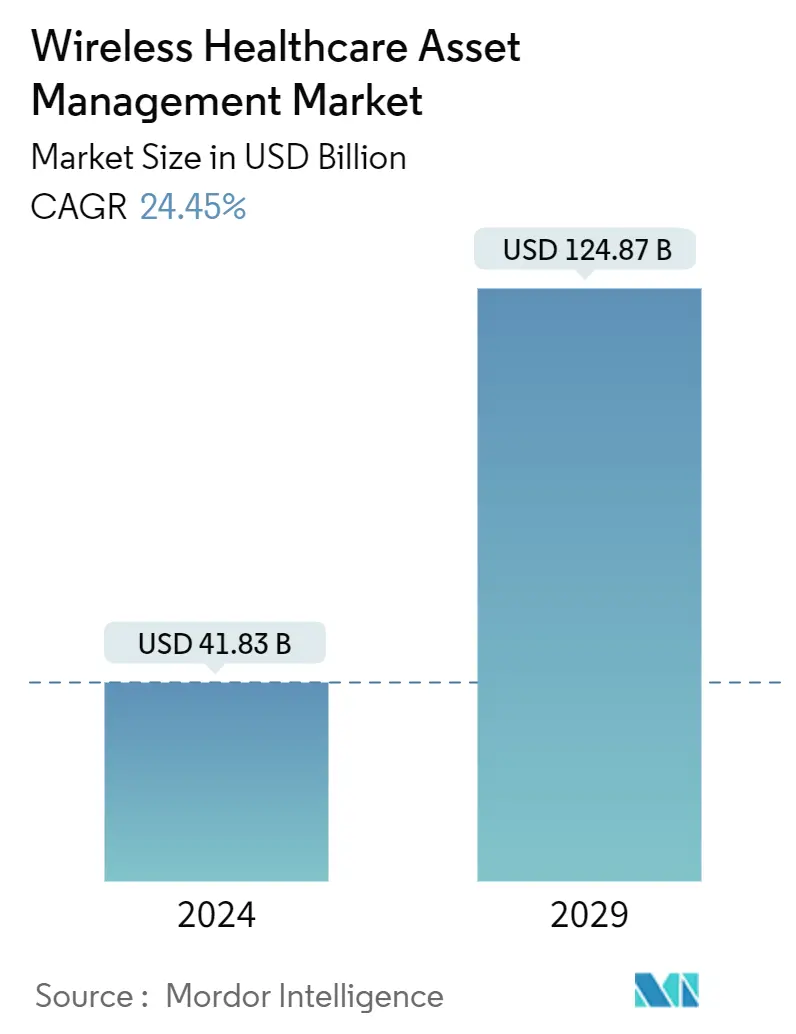Market Size of Wireless Healthcare Asset Management Industry

| Study Period | 2019 - 2029 |
| Market Size (2024) | USD 41.83 Billion |
| Market Size (2029) | USD 124.87 Billion |
| CAGR (2024 - 2029) | 24.45 % |
| Fastest Growing Market | Asia Pacific |
| Largest Market | North America |
Major Players
*Disclaimer: Major Players sorted in no particular order |
Wireless Healthcare Asset Management Market Analysis
The Wireless Healthcare Asset Management Market size is estimated at USD 41.83 billion in 2024, and is expected to reach USD 124.87 billion by 2029, growing at a CAGR of 24.45% during the forecast period (2024-2029).
The implementation of wireless healthcare asset management systems has been growing owing to the advent of trends, such as the Internet of Things (IoT), digitization, and automation of various processes. These advanced technologies help reduce the loss of expensive hospital equipment, leading to high capital losses.
- The employment of individual staff necessary for monitoring and keeping track of the equipment can also be avoided, which could prove an extra expense for the hospital. Implementing such technology increases the visibility of devices, reducing the time spent sorting and organizing equipment to avoid wasting time.
- A real-time asset monitoring solution allows the ability to control frequently changing situations and see across the hospital organizations to understand the workflow. From maintenance to procurement and even managing the database of a single software, each IT hardware equipment introduces incalculable vulnerabilities. Multiplying these risks by thousands and millions of servers, computers, sensitive equipment, and other storage devices, the magnitude of probabilities for security breaches, auditing mistakes, mismanagements, and human resources, among other critical resource diversions, inflates exponentially.
- Continuous and uninterrupted functioning of the healthcare equipment is pivotal to efficient patient treatment and care. As such, this equipment must be monitored occasionally and serviced/replaced accordingly. Using wireless asset management solutions helps hospital owners track the equipment's health and service requirements. This allows the hospitals to reduce operating costs and maintain efficient patient care.
- Previously, hospitals were reluctant to implement wireless technology for asset tracking, fearing that the signals might interfere with the medical equipment, thereby hampering the treatment and patients' health. However, over the years, companies have developed products that operate on different frequencies and do not interfere with the existing hospitals' equipment and machinery. As such, the demand \for such wireless devices for asset tracking is increasing as the end-users adopt the technology.
- The COVID-19 pandemic catalyzed technological adoption in the healthcare industry. The need for efficient and continuous patient care, along with safeguarding the hospital staff, was a critical factor in the technological shift in the healthcare industry. Wireless tracking of assets in clinics and hospitals reduces human movement across the premises. Also, as it gets easier to locate the asset without the need for interaction among the staff members, the benefits of wireless asset management have primarily been recognized by the stakeholders in the healthcare industry. Therefore, the demand for such wireless technologies is witnessing significant growth and is anticipated to grow over the forecast period.
Wireless Healthcare Asset Management Industry Segmentation
Wireless Healthcare Asset Management primarily involves using various wireless devices and sensors to track, monitor, and manage the assets used in the healthcare industry, especially hospitals. These devices include asset tags, wearable tags, and wireless sensors. Various technologies in these products make them a suitable solution, including Wi-Fi, RFID, and ZigBee.
Wireless Healthcare Asset Management Market is segmented by Products (asset tags, wearable tags, wireless sensors), by technology (RFID, Wi-Fi, zigBee), and by geography (North America, Europe, Asia-Pacific, and the Rest of the World). The market sizes and forecasts are provided in terms of value in USD for all the above segments.
| By Products | |
| Asset Tags | |
| Wearble Tags | |
| Wireless Sensros | |
| Other Products |
| By Technology | |
| RFID | |
| Wi-Fi | |
| ZigBee | |
| Other Technologies |
| By Geography | |||||||
| |||||||
| |||||||
| |||||||
| Rest of the World |
Wireless Healthcare Asset Management Market Size Summary
The wireless healthcare asset tracking market is experiencing significant growth, driven by the integration of advanced technologies such as the Internet of Things (IoT), digitization, and automation. These technologies are instrumental in minimizing the loss of costly hospital equipment, thereby preventing substantial capital losses. The adoption of wireless asset management systems enhances the visibility of medical devices, streamlining operations by reducing the time spent on equipment organization and management. This real-time monitoring capability is crucial for maintaining the continuous functionality of healthcare equipment, which is essential for efficient patient care. The shift towards wireless solutions has been accelerated by the COVID-19 pandemic, which highlighted the need for reduced human interaction and improved asset tracking to ensure safety and efficiency in healthcare settings.
The market is characterized by the widespread use of technologies like RFID and NFC for tracking medical equipment and supplies, with significant adoption in hospitals and clinics. These technologies, often combined with real-time locating systems, enable precise tracking of assets, enhancing operational efficiency and reducing downtime. The Asia-Pacific region is poised for substantial growth due to technological advancements and increasing healthcare infrastructure investments. The market is highly competitive, with major players like Cisco Systems, General Electric, and Verizon actively expanding their offerings through strategic partnerships and innovations. The ongoing development of IoT-based solutions and blockchain-enabled asset management is expected to further propel market growth, providing healthcare institutions with the tools needed to optimize asset utilization and improve patient care outcomes.
Wireless Healthcare Asset Management Market Size - Table of Contents
-
1. MARKET INSIGHTS
-
1.1 Market Overview
-
1.2 Industry Stakeholder Analysis
-
1.3 Industry Attractiveness - Porter's Five Forces Analysis
-
1.3.1 Bargaining Power of Suppliers
-
1.3.2 Bargaining Power of Consumers
-
1.3.3 Threat of New Entrants
-
1.3.4 Threat of Substitute Products
-
1.3.5 Intensity of Competitive Rivalry
-
-
-
2. MARKET SEGMENTATION
-
2.1 By Products
-
2.1.1 Asset Tags
-
2.1.2 Wearble Tags
-
2.1.3 Wireless Sensros
-
2.1.4 Other Products
-
-
2.2 By Technology
-
2.2.1 RFID
-
2.2.2 Wi-Fi
-
2.2.3 ZigBee
-
2.2.4 Other Technologies
-
-
2.3 By Geography
-
2.3.1 North America
-
2.3.1.1 United States
-
2.3.1.2 Canada
-
-
2.3.2 Europe
-
2.3.2.1 Germany
-
2.3.2.2 United Kingdom
-
2.3.2.3 France
-
2.3.2.4 Italy
-
2.3.2.5 Rest of Europe
-
-
2.3.3 Asia-Pacific
-
2.3.3.1 India
-
2.3.3.2 China
-
2.3.3.3 Japan
-
2.3.3.4 Rest of Asia-Pacific
-
-
2.3.4 Rest of the World
-
-
Wireless Healthcare Asset Management Market Size FAQs
How big is the Wireless Healthcare Asset Management Market?
The Wireless Healthcare Asset Management Market size is expected to reach USD 41.83 billion in 2024 and grow at a CAGR of 24.45% to reach USD 124.87 billion by 2029.
What is the current Wireless Healthcare Asset Management Market size?
In 2024, the Wireless Healthcare Asset Management Market size is expected to reach USD 41.83 billion.

